The week's pick
Random Articles
Reseach Article
Technological Advancements to Assist Visually-Impaired People: A Survey
| International Journal of Computer Applications |
| Foundation of Computer Science (FCS), NY, USA |
| Volume 187 - Number 9 |
| Year of Publication: 2025 |
| Authors: Maheshwari Kunte, Sarita Sanap |
 10.5120/ijca2025925021
10.5120/ijca2025925021
|
Maheshwari Kunte, Sarita Sanap . Technological Advancements to Assist Visually-Impaired People: A Survey. International Journal of Computer Applications. 187, 9 ( May 2025), 36-40. DOI=10.5120/ijca2025925021
Abstract
It is possible to use technology to support individuals with visual impairments. This paper provides a brief overview of several approaches that have been employed over time to assist people with disabilities. It covers digital, deep learning, and sensor- based methods. The study also includes an in-depth discussion of deep learning techniques and their deployment on edge de- vices. Additionally, the role of accelerators in modern computing is briefly addressed. Researchers seeking to explore further advancements in this field may find this study a useful starting point.
References
- M. I. A. Hossain, J. Anjom, and R. I. Chowdhury, “To- wards walkable footpath detection for the visually impaired on Bangladeshi roads with smartphones using deep edge in- telligence,” Array, vol. 26, p. 100388, 2025.
- V. K. N., B. S. Ullal, P. Gogoi, K. Singh, A. Biswas, and K. Yash, “Smart Navigation Aid for Visually Impaired Person using a Deep Learning Model,” in Proc. 2023 Third Int. Conf. Artif. Intell. Smart Energy (ICAIS), 2023, pp. 1049–1053.
- R. B. Islam, S. Akhter, F. Iqbal, M. S. U. Rahman, and R. Khan, “Deep learning based object detection and surround- ing environment description for visually impaired people,” Heliyon, vol. 9, no. 6, pp. e16924, 2023.
- D. Lunney, R. C. Morrison, M. M. Cetera, R. V. Hart- ness, R. T. Mills, A. D. Salt, and D. C. Sowell, ”A Microcomputer-Based Laboratory Aid for Visually Impaired Students,” IEEE Micro, vol. 3, no. 4, pp. 19–31, 1983, doi: 10.1109/MM.1983.291134.
- J. Brabyn, “Some new sensory aids for the visually impaired,” in Proceedings of the Annual International Conference of the IEEE Engineering in Medicine and Biology Society, 1988, pp.1582 vol. 4.
- N. K. Lodge and J. N. Slater, “Helping blind people to watch television—the AUDETEL project,” in 1992 IBC Interna- tional Broadcasting Convention, 1992, pp. 86–91.
- K. Thorn, “A talking measuring cup for the visually impaired, ” in Proceedings of the Johns Hopkins National Search for Computing Applications to Assist Persons with Disabilities, 1992, pp. 194–196.
- J. L. Leopold and A. L. Ambler, “Keyboardless visual pro- gramming using voice, handwriting, and gesture,” in Pro- ceedings. 1997 IEEE Symposium on Visual Languages (Cat. No.97TB100180), 1997, pp. 28–35.
- A. Tomita, T. Ebina, and R. Ishii, “An image processing method for use in a GUI for the visually impaired,” in Pro- ceedings of the IECON’97 23rd International Conference on Industrial Electronics, Control, and Instrumentation (Cat. No.97CH36066), vol. 1, 1997, pp. 264–268.
- S. Ram and J. Sharf, “The people sensor: a mobility aid for the visually impaired,” in Digest of Papers. Second International Symposium on Wearable Computers (Cat. No.98EX215), 1998, pp. 166–167. doi: 10.1109/ISWC.1998.729548.
- K. Magatani, K. Sawa, and K. Yanashima, “Development of the navigation system for the visually impaired by using op- tical beacons,” in 2001 Conference Proceedings of the 23rd Annual International Conference of the IEEE Engineering in Medicine and Biology Society, vol. 2, 2001, pp. 1488–1490. doi: 10.1109/IEMBS.2001.1020487.
- C. A. Avizzano, S. Marcheschi, M. Angerilli, M. Fontana, M. Bergamasco, T. Gutierrez, and M. Mannegeis, “A multi- finger haptic interface for visually impaired people,” in Pro- ceedings of the 12th IEEE International Workshop on Robot and Human Interactive Communication (ROMAN 2003), 2003, pp. 165–170.
- W. C. Lee and M. K. H. Leung, “SINVI: smart indoor naviga- tion for the visually impaired,” in ICARCV 2004 8th Control, Automation, Robotics and Vision Conference, vol. 2, 2004,pp. 1072–1077.
- E. J. Toledo, J. J. Martinez, E. J. Garrigos, and J. M. Ferran- dez, “FPGA implementation of an augmented reality appli- cation for visually impaired people,” in International Confer- ence on Field Programmable Logic and Applications, 2005,pp. 723–724.
- B. S. Tjan, P. J. Beckmann, R. Roy, N. Giudice, andG. E. Legge, “Digital Sign System for Indoor Wayfinding for the Visually Impaired,” in 2005 IEEE Computer So- ciety Conference on Computer Vision and Pattern Recog- nition (CVPR’05) - Workshops, 2005, pp. 30–30. doi: 10.1109/CVPR.2005.442.
- T. Roslak, “Navigation for visually impaired - leveraging ad hoc RF environmental sensing,” in CCNC 2006. 2006 3rd IEEE Consumer Communications and Networking Confer- ence, vol. 2, 2006, pp. 1316–1317.
- P. Manohar and A. Parthasarathy, “An Innovative Braille Sys- tem Keyboard for the Visually Impaired,” in 2009 11th Inter- national Conference on Computer Modelling and Simulation, 2009, pp. 559–562. doi: 10.1109/UKSIM.2009.66.
- M. A. Ahmad, T. Ahmed, M. Aslam, A. Rehman,F. S. Alamri, S. A. Bahaj, and T. Saba, “MathVision: An Accessible Intelligent Agent for Visually Impaired People to Understand Mathematical Equations,” IEEE Access, vol. 13,pp. 6155–6165, 2025.
- M. Kan, L. Zhang, H. Liang, B. Zhang, M. Fang, D. Liu,S. Shan, and X. Chen, “eLabrador: A wearable navigation system for visually impaired individuals,” IEEE Transactions on Automation Science and Engineering, pp. 1–1, 2025.
- S. Ikram, I. S. Bajwa, A. Ikram, I. de la Torre D´ıez, C. E. U. R´ıos, and A´ . K. Castilla, “Obstacle Detection and Warning System for Visually Impaired Using IoT Sensors,” IEEE Ac- cess, vol. 13, pp. 35309–35321, 2025.
- M. K, A. M. V. MV, C. S. V. Chandhrakiran, K. S, B. K. S. A.Krishna, and D. S, “AI-Powered Smart Glasses and Shoes for the Visually Impaired,” in 2025 6th International Conference on Mobile Computing and Sustainable Informatics (ICMCSI), 2025, pp. 1595–1603.
- F. F. Sakib, N. A. Akash, S. H. Rayied, M. S. I. Juel, andT. Hasan, “Enhancing Road Navigation for the Visually Im- paired: A Laser-Based Night Vision Approach,” in 2025 4th International Conference on Robotics, Electrical and Signal Processing Techniques (ICREST), 2025, pp. 129–133. doi: 10.1109/ICREST63960.2025.10914405.
- K. J, Z. S. Farooq, and P. Sirisha, “Vision Assist – Ob- ject Detection for the Blind,” in 2025 International Confer- ence on Intelligent and Innovative Technologies in Comput- ing, Electrical and Electronics (IITCEE), 2025, pp. 1–5. doi: 10.1109/IITCEE64140.2025.10915267.
- R. Shashanka, A. Devi, K. Lakith Gowda, S. Kushal, and V. Ravi Kumar, “VisioGuide: An AI for Visually Impaired,” in 2025 4th International Conference on Sentiment Analy- sis and Deep Learning (ICSADL), 2025, pp. 1084–1090. doi: 10.1109/ICSADL65848.2025.10932984.
- I. J. Cho, J. Park, and H. Bae, “A Computer Vision and Vi- brohaptic Glove-Based Piano Learning System for the Vi- sually Impaired,” in 2025 27th International Conference on Advanced Communications Technology (ICACT), 2025, pp. 334–338. doi: 10.23919/ICACT63878.2025.10936768.
- C. R. Mahlley, V. M. Raut, P. M. Sawai, M. K. Sat- pute, and A. Kale, “Enhancing Accessibility: A Real- Time Mobile Application for Visual Narration and Text Recognition for the Visually Impaired,” in 2025 IEEE In- ternational Students’ Conference on Electrical, Electron- ics and Computer Science (SCEECS), 2025, pp. 1–6. doi: 10.1109/SCEECS64059.2025.10940254.
- R. Jain, K. Gawande, A. Fadnavis, H. Bansod, P. Patne, S. Sawarkar, and S. Polade, “Smart Cap Design For Visually Impaired,” in 2025 IEEE International Stu- dents’ Conference on Electrical, Electronics and Computer Science (SCEECS), 2025, pp. 1–10. doi: 10.1109/SCEECS64059.2025.10941004.
Index Terms
Keywords

